by Tom Gaylord
Writing as B.B. Pelletier
Part 1 Reloading .22 rimfire cartridges
Part 2 Reloading .22 rimfire cartridges
Part 3 Bore size versus performance
Part 4 Reloading .22 rimfire cartridges
This report covers:
- Why reload rimfire?
- The real reason for shooting .22 rimfire
- No ammo!
- Loading the primed case
- The bullets
- The powder
- Static electricity
- Insert the bullet
- Crimping the bullet
- Try the cartridge fit
- Experience grows
- Summary
Today we will complete the reloading of the 28 .22 long rifle cartridges we have now primed. Reader GunFun1 says he’s been waiting for this one and so have I. Lotsa pix and lotsa talk. Let’s go!
Just as a reminder, this series was inspired by reader Yogi, who asked about reloading rimfire cartridges several months ago. As I have done for the 26 years I’ve been writing about airguns, I puffed up my chest and was about to bellow, “Rimfire cartridges cannot be reloaded.” However, in an uncharacteristically intelligent move, I went online, just to be sure. Lo and behold, not only can rimfire cartridges be reloaded, people have been doing so almost from the inception of the first .22-caliber rimfire cartridge by Smith & Wesson in 1856.
Why reload rimfire?
As airgunners we might ask why anyone would feel the need to reload .22 rimfire. We now have pellet rifles that produce over 100 foot pounds of energy at the muzzle and pellet rifles passed rimfires for accuracy out to 50 yards many years ago. The only drawback a good pellet rifle has is actually one of its biggest benefits — diabolo pellets don’t carry nearly as far as bullets. But the .22 long rifle cartridge we are talking about reloading is usually restricted to shots of less than 100 yards, and in the limits of that domain it only surpasses the accurate and powerful pellet rifle between about 50 and 100 yards.
The real reason for shooting .22 rimfire
The real reason for shooting .22 rimfire is the size of the support tail. A good rimfire rifle and 500 cartridges can be carried easily. An equally good pellet rifle can weigh almost the same as the firearm and, while 500 pellets are certainly lighter than a brick of long rifle cartridges, it doesn’t end there. Spring-piston guns and CO2 guns are not competitive in this arena. Only precharged pneumatics can play, because of their power and accuracy. That means there also has to be a means of refilling them. A hand pump is the lightest and most convenient way to replenish high-pressure air over the long haul, with a small carbon fiber buddy bottle coming next — because it only holds limited air.
A hunter can put a box of 50 rimfire cartridges in his pocket and be out for an entire day. An airgunner might get 20 good shots from a powerful AirForce Condor or an AirForce Escape and then he has to top off. While 20 shots are probably all he needs for hunting, the small box of 50 long rifle cartridges is dwarfed by the salami-sized buddy bottle. I can understand why a nice .22 rimfire is still respected so much. There is just one problem.
No ammo!
It’s very hard to find .22 long rifle cartridges in the United States right now. That won’t change with the new administration, either. If anything, it will get worse. So reloading rimfire that we once thought impossible and then, when we learned it could be done, we wondered why anyone would go to the trouble, has taken on a whole new perspective. You may be sitting on a few bricks of long rifle cartridges and if so, good for you. But don’t expect to replace them easily any time soon. The only rounds I found for sale are selling at 56 cents EACH! At that price a box of 50 rounds costs $23 and you can add a zero for a 500-round brick. So, if you want to shoot a lot, this may be the best and most affordable way real soon.
Loading the primed case
To load a primed case you must do two things — put in a charge of gunpowder and load a bullet. The instruction sheet sent by Sharp Shooter, the company that made the reloading tools, gave several gunpowders that might be used. One of them was Hogden’s Pyrodex P — a replica black powder that’s equivalent to FFFG, which is pistol powder. While most smokeless gun powder is currently unavailable, Pyrodex is still being sold and I bought a pound of it for this series. But as a replica black powder Pyrodex produces a lot of smoke and I didn’t want to stink up my office. So I used Bullseye gunpowder that I had plenty of. When you see how little was used you will appreciate that I can get about 7,750 cartridges from one pound of powder.
The bullets
The other thing you do is push a bullet into the cartridge case and crimp it. That proved to be a problem. The bases of all the 38-grain bullets I had cast had flashing on their bottoms. It had to be removed before the bullet would slide into the case. I used a combination of my fingernail and a small pen knife to do this.
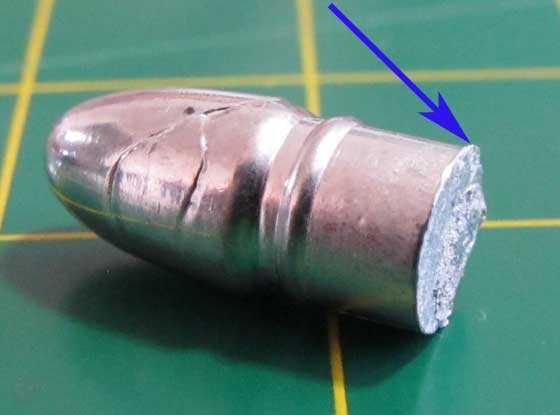
All the 38-grain bullets had flashing (arrow) around their base that had to be removed. This wrinkled bullet will be used to test velocity. I don’t usually accept bullets that are malformed like this but I still have to get the bullet mold working correctly.
Most of the 25-grain bullets had very little flashing on their bases. One, though, had a lot and it all had to be removed before the bullet could be loaded
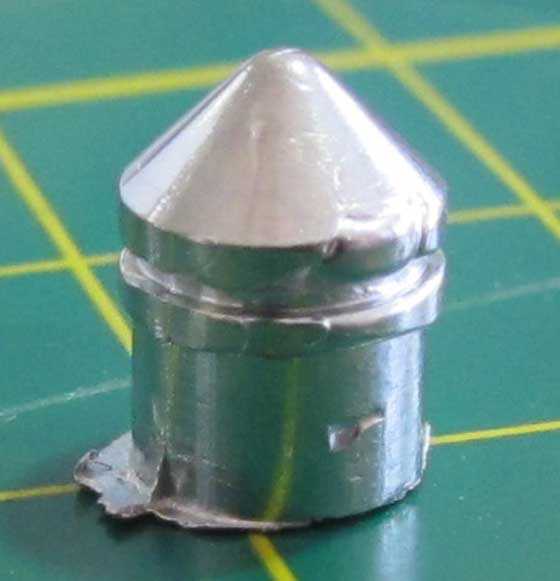
This 25-grain bullet is also unacceptable and will only be used to test velocity. All that flashing at the base had to be removed.
It took longer to prepare the bullets than to fill the case with powder, so the bullet was the first thing I did and then I loaded the powder. I loaded one cartridge at a time. My first cartridge probably took me five minutes to complete, but by the end of the session I was loading each round in about a minute and a half, give or take.
The powder
To verify the accuracy of the powder scoop I used a digital powder scale that’s made for measuring gunpowder. The same scoop I used for the priming powder was used to scoop out the Bullseye, that was in the same shot glass I used to mix the four priming powders (see Part 4). The small scoop picked up 0.6-grains of Bullseye, and the large scoop picked up 0.9 grains.
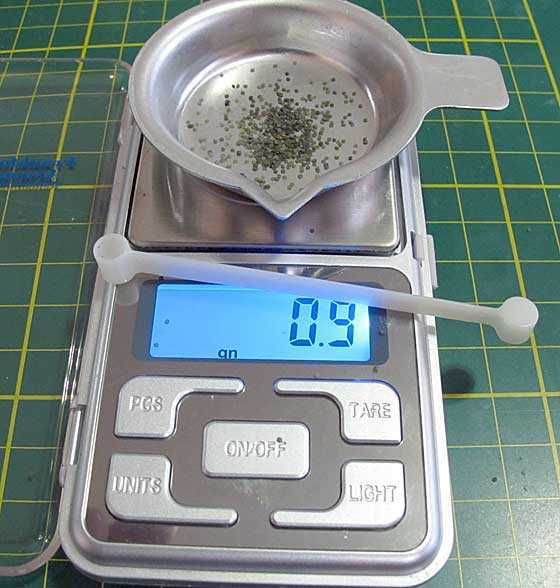
The large scoop that came with the rimfire reloading kit measured 0.9-grains of Bullseye gunpowder consistently.
I scooped and measured many scoops of powder and it was consistently 0.9-grains — never more. One time it was 0.8-grains and then crept up to 0.9-grains, so I felt the charge was on the lower end of 0.9-grains. I became confident that the scoop was always picking up the same amount of powder. So I stopped measuring and started reloading.
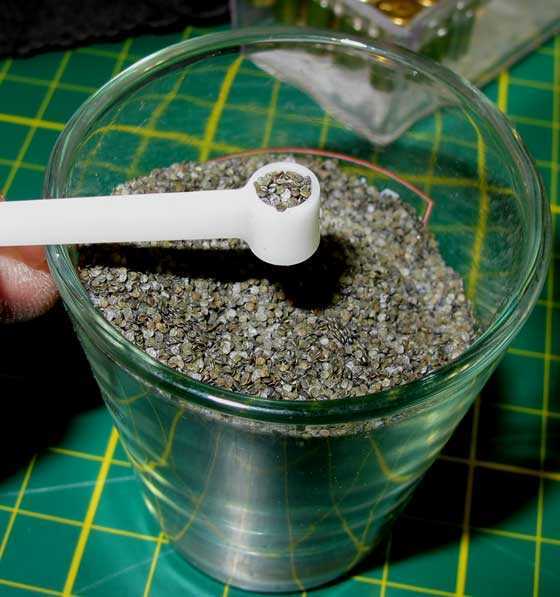
The large scoop consistently gathered 0.9 grains of Bullseye powder.
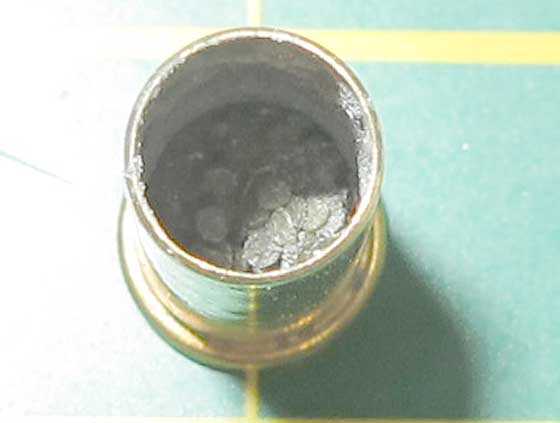
Here we are looking down inside the cartridge after powder has been put in. It fills about the bottom third of the case. But of course the bullet will take up some space inside, as well. With smokeless gunpowder the case doesn’t have to be full for safety reasons like it does with black powder.
Static electricity
The gunpowder has some static electricity and some of it sticks to the inside of the plastic funnel after the cartridge is loaded. I used a brass cleaning rod swab holder to push the stray flakes down into the spout of the funnel when tapping the side with a finger wasn’t enough.
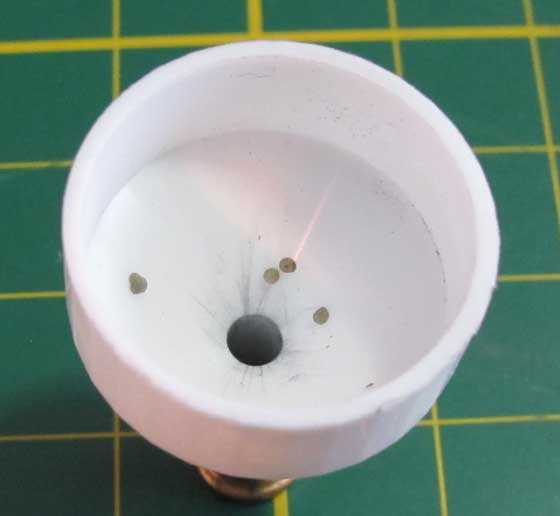
Static electricity held a few flakes of gunpowder to the side of the funnel. They were pushed into the spout by a brass fixture.
Insert the bullet
Now the bullet can be inserted into the case. If the bullet base was cleaned of flashing it goes right in and stops at the right place — hopefully. The first 38-grain bullet I loaded didn’t go into the case far enough and was crimped in the wrong place. But I learned from that and didn’t make that mistake again with that bullet.
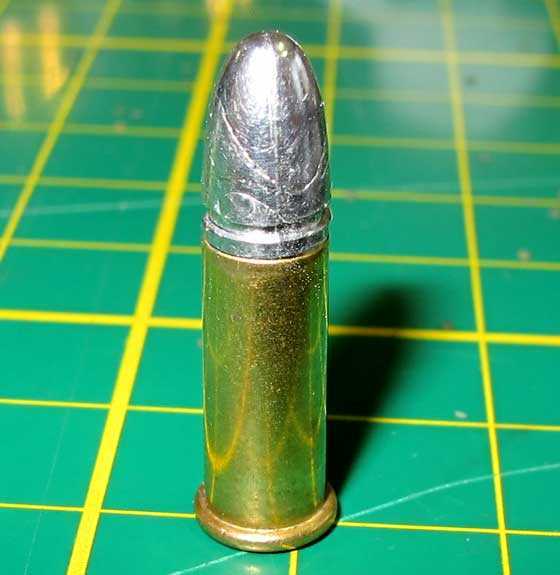
The bullet has been put into the case.
Crimping the bullet
The last step in reloading is to crimp the case mouth into the side of the bullet, to hold it steady. The bullet mold that came with the reloading tools has a case crimper built into it. It is sized for long rifle cases, which means it will also work with longs but not with shorts. However a short case can be crimped if you come in from the other side (which is the top) of the crimping tool.
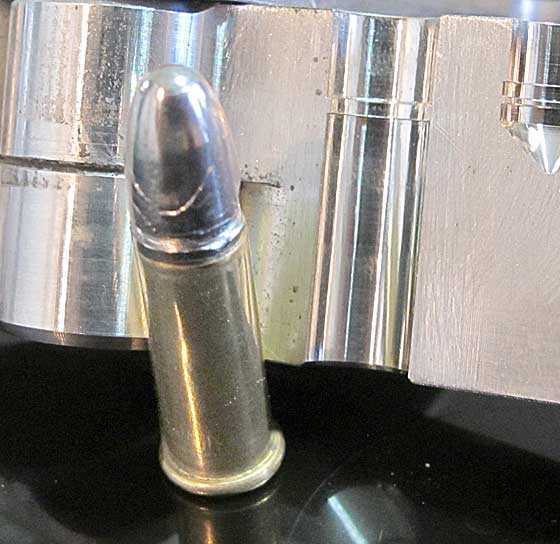
The cartridge is put into the crimping tool and the case mouth is crimped to the bullet.
On the first cartridge I discovered that it takes a little fiddling to get the cartridge into the crimping tool correctly. The first one I tried was put in too deep and I almost crimped the rim of the cartridge! That could have set the cartridge off! But I played with it and got the cartridge in correctly.
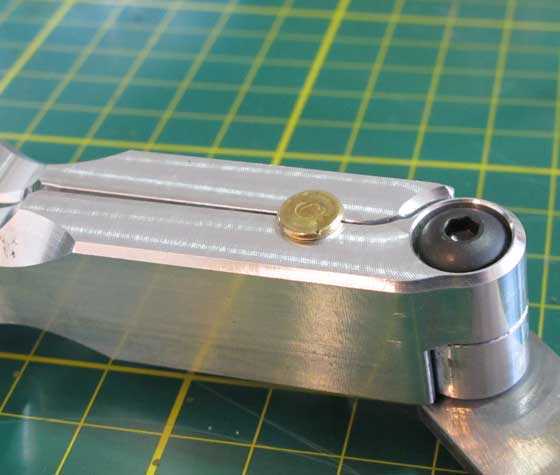
This is how deep the cartridge fits into the crimper.
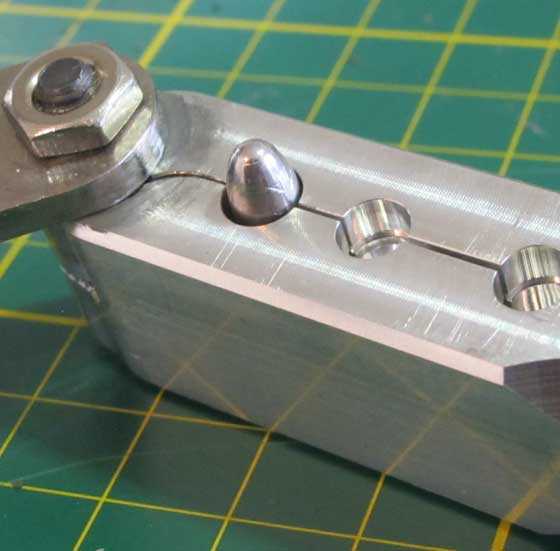
This is how far the 38-grain bullet sticks out when the case is loaded into the crimping too correctly. The shorter 25-grain bullet sits deep inside the tool and doesn’t stick out like this
When the cartridge is all the way inside the crimping tool, squeeze the handles hard and the crimp is made. It doesn’t look that deep, but it really does hold the bullet tight in the case.
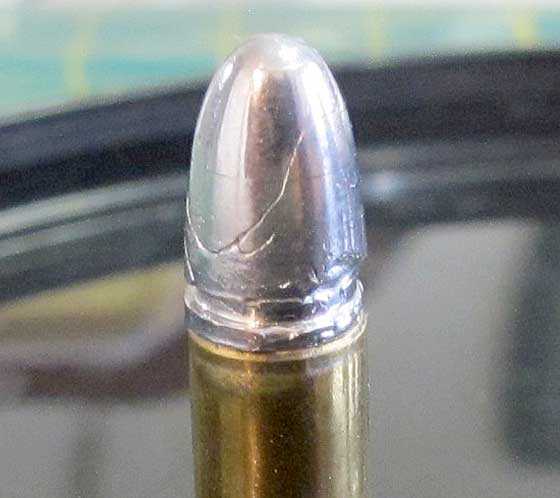
The crimp at the top of the case mouth holds the bullet tight.
Try the cartridge fit
After reloading the first cartridge I tried inserting it into the chamber of the rifle I plan to test it in. The cartridge with the 38-grain bullet went about halfway into the chamber. I was able to close the bolt all the way on that cartridge but when I opened it again, the bullet was pulled out of the case and remained stuck in the barrel.
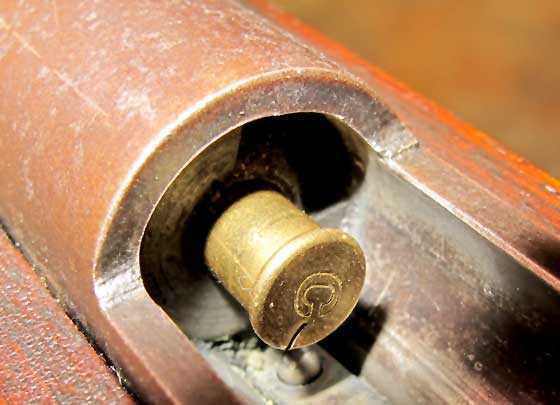
The cartridge with the 38-grain bullet went this far into the rifle’s chamber before it stopped. The bolt shoved it in all the way.
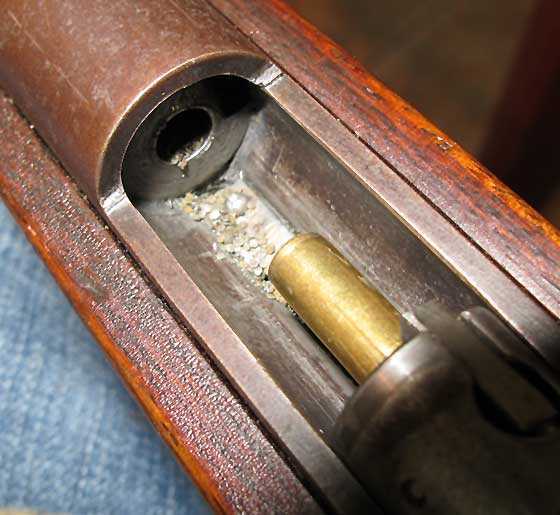
When I opened the bolt to extract the cartridge, the bullet remained in the barrel.
I pushed the bullet out of the barrel with a .22 cleaning rod and reloaded it into the cartridge, but first all the powder had to be removed and refilled.
When I loaded the 25-grain bullet into a cartridge and crimped it, it went deeper into the chamber, but not all the way. I didn’t force this one into the chamber with the bolt. When the cartridge was removed the bullet remained in the case. I believe the crimping step is making the case out-of-round just enough to affect it this way.
Experience grows
As I reloaded the cases I got faster and better at it. By the time I loaded the five 38-grain bullets for the accuracy test and the 25-grain bullets as well, I was under a minute and a half loading a cartridge.
This is the first time I have ever done this, so there was a lot to learn. But now that I’ve done it, I know what to expect and things will go more smoothly.
If you add together all the time it took to cast the bullets (Part 2), mix the priming powder and prime the cases (Part 4) then load the cartridges (today), I probably spent about six hours loading 28 long rifle cartridges. Don’t think that’s how long it takes, though. I was doing many other things like taking pictures, plus learning how this all works. I think my estimate of 1.5 minutes per loaded cartridge (starting with a primed case) could be tripled and you’d have a rough estimate of the time it takes to cast and sort the bullets, prime the cases and load the cartridges. A box of 50 cartridges would take 225 minutes (at 4.5 minutes per cartridge, total), which is 3 hours 45 minutes.
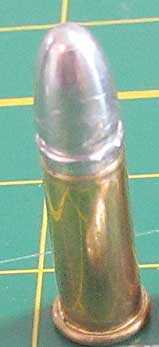
A 38-grain cartridge.
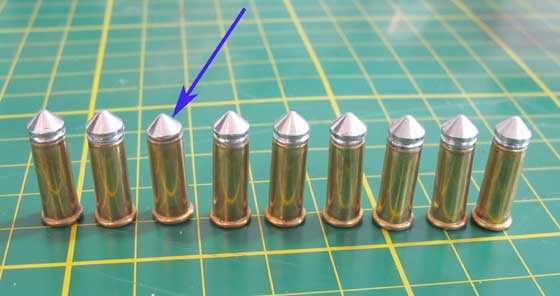
These are the nine 25-grain bullet cartridges I loaded for the velocity test. The arrow points to one whose bullet is seated too deep.
Summary
Three months ago I didn’t even know it was possible to reload .22 rimfire cartridges. Now I am finishing Part 5 of a series on doing it, and my first 28 cartridges are loaded! Most definitely there is a long road ahead for me as I refine each aspect of what I’ve reported so far. But this is something I’m interested in learning and, from what you have told me, you are too.
I know this is a blog about airguns and that the .22 rimfire cartridge certainly does not qualify, but in these perilous times when ammunition is difficult to find, shooters need all the help they can get. Many are either not yet informed that pellet rifles have come as far as they have (shooting one-inch groups at 100 yards and killing whitetail deer at 200 yards with one shot) and it’s my job to inform them.
Others are not yet ready to give up their beloved rimfires simply because ammunition is not available. They may know a lot about airguns and may even own several, but they still love their rimfires. Well, bless their hearts! Perhaps I can help them as we all learn about this fascinating niche in the shooting sports together.


Why do you think the current administration will make rimfires more scarce? They have been for the last 8 years here.
B.B.,
So I get it if there is no .22 Rimfire ammo to be had this would be a way to stay in the game, but…
“The only rounds I found for sale are selling at 56 center [maybe fix this? cents] EACH! At that price a box of 50 rounds costs $23 and you can add a zero for a 500-round brick. So, if you want to shoot a lot, this may be the best and most affordable way real soon.”
But even if I ignore the cost of the primer/powder (or even the pound of commercial Pyrodex) substitute kit
“A box of 50 cartridges would take 225 minutes (at 4.5 minutes per cartridge, total), which is 3 hours 45 minutes.”. My labor compensated at Biden’s $15.00 Minimum Wage comes out to a bit under $60.00 for a Box of 50 rounds!
As I said before I understand the value of being prepared to do this. BUT, at my labor rate (before my last retirement as an Open Water/Beach Lifeguard) I could easily afford to buy two bricks of 500 without working but part-time every day; and I enjoyed the outdoor work and scenery very much!
Just sayin’, ammo used to be cheaper than dirt! Don’t expect it to ever be that cheap in our lifetimes.
shootski
I can pick up a brick once a week at big5. It’s not unobtanium.
BB
Since I probably won’t be using smokeless powder how can I take up the air space when I use black powder?
And do you think that the air space might not be a problem when using smokeless since its not producing as much pressure like the big centerfire rounds like a 30-06 round?
And what do you think needs done to correct the out of round problem or whatever the problem is with the case not loading right in the chamber?
Gunfun1,
I would check BB’s crimping tool for out of round first and then since he is using Fireformed cases it could also be the rifle chamber is out of round or is dirty.
As far as fillers for the space: https://www.shootingtimes.com/editorial/fillers-for-reduced-rifle-loads/316610 For Black Powder I would use something like Semolina, Farina, Kapok, before I used a polyester filler to avoid the bore deposits.
shootski
Shooting
I wonder if BB needs to buy that sizing die they sale also. Maybe that is why the problem is happening.
And maybe more powder is needed when using black powder compared to smokeless and then you don’t have to worry about the air space?
GF1,
You fill the case a little too high for the bullet and then the bullet conmpresses the powder when it is loaded. It’s easy.
BB
BB
But I want to make a lower powered round so I will be using less powdered than you used.
So do I seat the bullet deeper?
And I think Bob is on to something with rotating the bullet in the crimper to crimp evenly around the case.
GF1,
With black powder what you do is first put in the black you want to use and then put in corn meal to take up the rest of the space in the cartridge.
But black powder will only be 2/3 as powerful as smokeless to begin with, so try it that way first.
Yes, rotating the crimper is important.
BB
BB
Ok I that’s what I was wanting to know about the black powder.
And as far as the cornmeal or other fillers it probably shouldn’t be compressed much I’m thinking. Basically just enough to take up the space between the powder and bottom of the lead bullet I’m thinking.
And ok about the crimper.
B.B.,
When you touch off the deep seated 25 grain round do you expect an elevated pressure or will perform as usual?
Siraniko
PS Introduction 2nd paragraph 3rd sentence, “However, in an uncharacteristicly (uncharacteristically) intelligent move, I went online, just to be sure.”
Siraniko,
To tell the truth I don’t know what to expect.
Fixed the spelling.
Thanls,
BB
BB
If I remember correctly the cases of larger rounds expand into the barrel when fired and therefore need to be re-sized before reloading and then you may need to trim the case length if the process caused it to lengthen and screw up the head spacing, so to speak.
Could it be that .22 cal shells also expand some when fired and the crimper that seats the bullet was never intended to resize (shrink) a shell but to load new shells? The result may be an oval crimp.
When we crimp ends on aircraft cables you need to rotate things when they are being crimped for a precise strong crimp. Perhaps rotating the bullet, at least 90 degrees, for another crimp would help. Even more rotating and crimping would probably be better? ( I skipped the previous blogs on this so I may be covering old material or missed something. ) I don’t plan to reload these, for now, but I will save the brass. A day late and thousands of rounds lost already.
Bob M
Bob,
You are getting ahead of things, but yes, you are right.
BB
Bob
I just mentioned above to BB that I think your right about rotating the bullet when you crimp it.
BB
I just thought of something after looking at the picture with the flakes of gun powder in it but no bullet loaded yet.
And this is also about air space. If you take a bullet and load it in the gun the case will be horizontal. So you know what that means. Now all the powder is on one side of the case and the top of the case on its side has the air space.
You would think that would push the bullet out of the case with the bullet trying to tip upwards as it starts moving forward.
I think air space would be a bad thing for accuracy after thinking about where the gun powder would be.
GF1,
That same thing happens with every store-bought .22 rimfire and you never noticed it.
BB
BB
I know but what I was getting at is I never thought about that before.
But thinking now about what you just said. Has anyone ever studied that about reducing the air space to make more accurate rounds? Or I should say to see if it does makes more accurate rounds.
GF1,
Yes. Dr Mann studied it for 37 years and then wrote a book, “The Bullet’s Flight From Powder to Target.” I have mentioned it in several blogs in the past. Maybe it’s time to look at it again.
BB
BB
I remember you mentioning the book.
And sure. Why not look at it again. Maybe it could be linked to this blog about rimfire reloading.
That might even draw in some firearm shooters to the air gun world.
BB-
Errata- Section ‘No ammo!’, third from last sentence-
‘…are selling at 56 center (cents) EACH!’
I just checked the website AMMOSEEK, and there seems to be a number of flavors of 22 LR available for less than that. Still high priced, but much less than $.56 a round.
I think rollsizing each case before priming would be beneficial to ensure roundness near the base.
I’m also thinking that I wouldn’t be interested in reloading 22 LR due to economies of scale and time invested. Now the larger obsolete calibers do interest me. I have a Spencer military rifle (56-52?) that could be fun to shoot.
For a 22 rimfire, I’m considering trying a Diablo pellet powered by a nail gun blank. There are several YouTube videos about this. Interesting results to say the least.
Paco,
Fixed the error. Thanks.
A brick (500) of DISCOUNTEED Norma .22 costs $113.99! That’s 22 cents per round! I didn’t know about AMMOSEEK, but it’s still no bargain.
BB
BB,
Another fascinating installment.
Q: Is there higher end kits that would make things easier (like there is in traditional reloading)?
Q: Why,…………??? exactly is there an ammo shortage today? To clarify,… I can see fear as being a driver,.. ok. I can see see supply and demand creating shortages,… ok. BUT,.. at some point,… any business worth their salt would seriously ramp up production to meet the increased demand. So,…. why haven’t they?
Chris
Chris
Last I heard rich Democrats were buying up ammunition companies. Doesn’t make any financial sense to slow down production unless you have political reasons?
I picked up a real brick, as far as weight goes, a little while back at Walmart. A 1,000 round box of Winchester M22 LR black copper plated round nose and they had lots more. I thought the shortage was over? Haven’t looked lately.
Also, I think by the time the bullet reaches the end of the barrel the barrel rifling and pressure behind the bullet would have stabilized it, if there was any imbalance in the first place
Bob,
Well,.. I did not know, so that is why I asked. Nothing would surprise me anymore,… nothing at all.
Like you said,.. it makes 0% business sense to not meet demand.
I was hoping for a bit more than,…. “Last I heard …….” though.
Thanks,…. Chris
Chris,
Okay, watch this.
https://www.youtube.com/watch?v=E5zNNk130V0
BB
BB,
Thanks. I watched it and one other that pretty well said the same thing. Good to hear the manufacturers are cranking it out and it is more of a supply/demand than anything else.
Chris
B.B.
Is this the “New” blog, or are we still using the old system?
-Y
Yogi,
The old one, though I have started designating a featured image.
BB
This is an interesting read. I don’t think that reloading 22 rimfire will ever be a necessity or a real option but it sure is interesting.
I don’t know if BB has ever done a blog on casting or making pellets, but that would be interesting too.
David Enoch
“…a blog on casting or making pellets…that would be interesting…”
David, I second that idea. =>
David
It seems that swaging kept getting brought up in the past when the subject got brought up about casting pellets. Which is fine.
Maybe swaging bullets or pellets would be a lttle quicker than casting. ???
GF1,
There is a new 20 gauge slug/shot gun air gun out now. Just saw the video on GTA. Pistol and carbine version with a 2 shot block mag.. I post a link later if it comes back up unless you already know about. Very tactical looking. The mag. is the shell. You load it with whatever you want. Anything.
Chris
Chris
No haven’t heard but definatly post the link.
And I got the empty shot shells for my Wingshot that I can load with whatever I want.
Lets put it this way. I had some pretty dramatic redults loading some watcutter and pointed pellets in the shells.
I’ll put it this way. I wouldn’t want to get hit by it at 20 yards and in. Its tearing things up when it hits.
GF1,
Casting pellets doesn’t work very well. Swaging is the way they are made.
BB
BB
Maybe I will make a swage for my .22 rimfire reloading. I was going to make one once for my air gun. It seems it would be faster I think.
Maybe not though. Guess I would still have to melt the lead and then make some blanks of lead to swage.
Not sure what way I will go yet.
GF1,
There was a video of a guy using hydraulics to take lead ingots and forcing them through a funnel mold. It would shoot out a long rope of lead wire to be used for swaging. The whole set up was pretty small and would easily fit on a 4’x4′ table.
Chris
Chris
That sounds like a cool idea.
I think to do all this different stuff with the reloading. I’m afraid I’m going to have to wait till I retire.
I would like to get a little assembly line of some sort made up so I could become more efficient loading the rimfire bullets.
GF1,
Yea, it was pretty cool. This long rope of lead wire came squishing out the top and looked to be 5-6′ long for each pressing. Maybe 1′ per second.
I did find that .20 gauge air slug gun/shotgun that I was telling you about. I searched GTA over and over and it was like the post disappeared or something or I just missed it. There is a video in the link but I do not think it is the same one I watched. The one I saw was one where they were out shooting it. At least this gives you a start point to find out more.
Guns and related ammo are in stock per the video I watched.
https://www.survivalairguns.com/products/sw-airguns-fd-15t-pcp-big-bore-air-shotgun-carbine-20-gauge-with-ar-stock
Chris
Chris
Ok thanks I will check out the link on the air shot gun.
And I’ll have to search and see if I can find that video of the hydraulic press. I could make something pretty easy I believe. Thats exactly what I work on at work. Hydraulic systems.
GF1,
Here is the other 20 gauge shotgun video:
https://www.gatewaytoairguns.org/GTA/index.php?topic=183423.0;topicseen
Chris
Chris
Checking it out now.
Cool stuff. Glad that more are coming out.
I got a squirrel the other day at the top of a big old Oak tree. Bet he was 25 yards up. All I can say is it thumped him good. He was doa when he hit the ground. Only bummer was getring all that number 8 bird shot out of the meat. Wasn’t as bad as my 20 and 410 gauge shot guns though. So that was kind of nice.
And ordered my dovetail rail for the Wingshot yesterday but forgot to order the dovetail to Picatinny adapter. I want that and some quick release scope rings I can leave the adapters on and take the scope on and off.
Chris
Ran out of time on my reply above.
But the dovetail rail and quick release scope will be to shoot the 210 grain .50 caliber Blaundau slugs.
I want to be able to go back and forth from a shotgun to a slug shooter real quick by mounting and unmounting the scope. Hopefully the scope will hold a repeatable zero with the mounting and unmounting.
All I’m worried about is a 2″ repeatable kill zone at 50 yards with the scope mounting and unmounting for the slugs.
I think I should be good.
B.B.,
Here we have yet another fascinating report…you’ve got me saving my .22 brass; and I already have a couple of pound of Pyrodex P, so that’s good. =>
On my brother’s farm, the gun that gets shot the most is his Red Ryder…plenty of ammo for that! He taught my nephews how to shoot with that gun and a lot of tin cans: line up a row of cans on top of the fence and take turns seeing who takes down the most cans with the least amount of shots…good family fun!
My brother also has a nice old Marlin model 39 with a peep sight on it, which my nephews would love to shoot, but there is no ammo in his area. Hence, I gave him a brick of .22LR ammo for it, and the kids are happy.
Here on the mini-farm, the .22 that gets shot the most is my HW30S; I made a new 25-yard range (steel trap, as noted in your previous blog); so now I can shoot dead on at 15 yards, hold one dot high for 25, and even at 40 yards, I can hit a pecan most of time with a 2-dot-high hold. Thanks to PyramydAir’s “buy 3 get one free” deal on pellets, I’ve got many tins for that rifle, and that takes the pressure off my .22LRs.
However, I did find a couple thousand more rounds than I thought I had; I guess I stocked up a bit more than I realized, back when the gettin’ was good. So now you may be thinking, “Wow, ol’ dave is pretty smart.”
No, sadly not so; if I was smart, I would have invested in plexi-glass and pressure-treated wood 2 years ago!
(To anyone who did so, my hat’s off to you! =>)
Thanks for another great report; keep up the good work!
Take care & God bless,
dave
BB,
I have too many hobbies to consider getting into reloading but I am thoroughly enjoying this series!
Static electricity is a nuisance with fly tying as well.
I use a grounded “anti-static” matt (available from electronics suppliers) on my bench and wipe my equipment with one of those “Bounce” anti-static sheets (that are used in a clothes dryer) to stop fine fibers and synthetic materials from clinging to things. That might help stop the powder sticking to the funnel.
A quick solution might be an anti-static bag (one of those silvery-blue plastic bags used to protect computer boards) might work as well if you electrically connected it to something that is grounded (like your computer chassis). If you don’t have one anybody who assembles computer would be glad to give you a couple.
Hank
Hank,
Thanks for the offer. Got a lot of watcer to get under the bridge before then, though.
BB
Regarding ammo shortages, ammo production is not being restricted, but demand has ramped up many times the normal level. As with any consumer product there is a pipeline of production, shipping, retail stocking, and retail purchase. As long as people are not in scarcity panic mode, things flow smoothly and items are available as needed and at normal prices. When the public or a segment of the public becomes convinced that there is threat that will limit their supply or that there will be a critical event, panic buying starts. When that happens, personal inventory increases dramatically and the pipeline is sucked dry. Recall the grocery store supplies of paper products, water and milk selling out in advance of a major weather event. I know that starting a few years ago my personal inventory of som items has increased many times over.
In another life I was in marketing for a major oil company. During the energy crunch in the 70s gasoline rationing was implemented. People who would drive with a quarter tank of gas all the time suddenly had to have the tank full all the time because gasoline might not be available. That attitude created a self-fulfilling condition, indeed gasoline was scarce. In the industry the condition was called “rolling storage.” The short term will continue to show scarcity. When the panic subsides, demand will drop to normal levels and supply will catch up.
Dan
The shortage made me think about my box of accumulated .22 ammo. I did a lot of shooting when I lived in Virginia and would buy a few bricks when I found something that worked well. I packed everything up 15 years ago when I moved to New Mexico and most has stayed packed. I found that I have a small fortune in untouched bricks.
I have more than I will shoot if I live to 100, so plan to box up a lot of stuff and visit my local gunshop to see what kind of cash or store credit I can get. Guess I could claim that I’m doing this to help out my fellow shooters, but suspect greed has more to do with it.
And now I know not to bother looking in stores and dealing with high prices. Win, win!
Good luck with reloading project. You might look for some Triple 7 powder. It is a black powder substitute like Pyrodex, but burns much cleaner. It also might be available vs most smokeless powders. I’ve used the pellets. Much cleaner!
Gene,
I have Triple 7 on hand. I’m using Pyrodex at present.
BB
Well I think ole Gunfun1 was smarter than he thought he was. Sort of.
I have always kept a good supply of ammo I use. Plus saved his firearm cases and lead.
But Gunfun1 might not been smart enough. Probably should bought the other popular firearm bullets throughout time too. Oh well that time is past. Or is it?
All I know is the rimfire reloading has opened my eyes. I have a lot of cases and enough lead. Now for some powder And I will be shooting rimfire for a long long time.
All I can say is thanks to Yogi and BB for opening my eyes.
Definitely a blog that will be remembered throughout some time in the future.
BB, you are to be recognised for even attempting this project. I was thinking you would use new, preprimed brass,
factory bought bullets, and the right tools. Boy was I wrong. I also think there may be some liability issues for a quality consumer kit maker, something I might be interested in. I like the possibility of the control that a kit might offer,
more than the cost of the ammo, if I cant compete on cost of manufacture for lower end ammo from a big name maker, then rolling my own at least would allow me to taylor them to a specific requirement I have, say 50 grn @ 900fps. But, even static electricity can make things go bang in this process and thats the good news about PCP’s, they have come a long way. You cannot easily buy a Sheridan ‘ashcan’ pellet anymore, thank goodness
R
B.B.
Wow, was I surprised how accurate those little scoops are.
Looking closely at the noses of the cast bullets, I see many small imperfections. Will these affect accuracy?
The tools used look well made. but are they really precise enough? I would think that a 3-d printed bullets though an additive process would be more exact. Similarly, if the “necking tool” had multiple crimpers it would do a better job.
Well, what do you expect at an Earl Scheib price? Just wondering if better/ more expensive equipment-if it even exists for the unloved .22, would end up with a better end product? How does the reloading time compare to reloading center fires?
Thanks, interesting report,
-Yogi
Yogi,
Yes, those imperfections affect accuracy because they throw off the balance of the bullet in flight.
The reloading time is many times longer than for centerfires.
I’m, getting so much out of this that I’m thinking of writing a book.
BB
I just look stupid!
That is my story and I am sticking to it……. lol.
-Y
B.B.,
Careful! Don’t lose FOCUS…
You started this to reload for that Rimfire Deringer. Now that WILL be cost effective!
shootski
shootski,
No, I started this to see if it is possible to reload .22 rimfire. Read Part 1. The .41 rimfire came up because I also noted that it would be possible to reload them, as well. But .22 rimfire has been my main thrust for this series.
BB
B.B.,
Oops!
My bad for not Fact Checking.
shootski
FM’s 2 Cents’ Worth, with the caveat this may make no sense since despite the fact we’re dealing with ballistics, he’s no Von Braun. In terms of cost of reloading vs buying commercial-made vs making the Ramset blanks Rube Goldberg ammo, a box of the #4 Ramset cartridges cost $7.64 at a local Big Box, for 100 units. After factoring in sales tax, gas used getting to the store and one’s time, this comes to $0.08 per cartridge. 300 .22 airgun bullets/slugs can be had for $26 including shipping. So the total cost per round would be about $0.20; not wonderful, but about half the cost of commercial, though substantially more than reloading. This could be an option for those who have little or no .22 rimfire
Wish hadn’t duplicate-commented myself; brain-and-tablet hiccup. 🙁
FM’s 2 Cents’ Worth, with the caveat this may make no sense since despite the fact we’re dealing with ballistics, he’s no Von Braun. In terms of cost of reloading vs buying commercial-made vs making the Ramset blanks Rube Goldberg ammo, a box of the #4 Ramset cartridges cost $7.64 at a local Big Box, for 100 units. After factoring in sales tax, gas used getting to the store and one’s time, this comes to $0.08 per cartridge or thereabouts. 300 .22 airgun bullets/slugs can be had for $26 including shipping. So the total cost per round would be about $0.20; not wonderful, but about half the cost of commercial, though substantially more than reloading. This could be an option for those who have little or no .22 rimfire/can’t or don’t want to reload. These “mini naval shells” – call them that because of how they load – are a little tricky to set up, more so if a pellet is used. This video may be helpful in that regard. If you go this route, be extra careful and make sure your “shooter” is up to the task. I wouldn’t use my prized or vintage .22 rifle, carbine, revolver or pistol for this. FM wrote too much; head exploding.
https://www.youtube.com/watch?v=WFm-qivOSGw